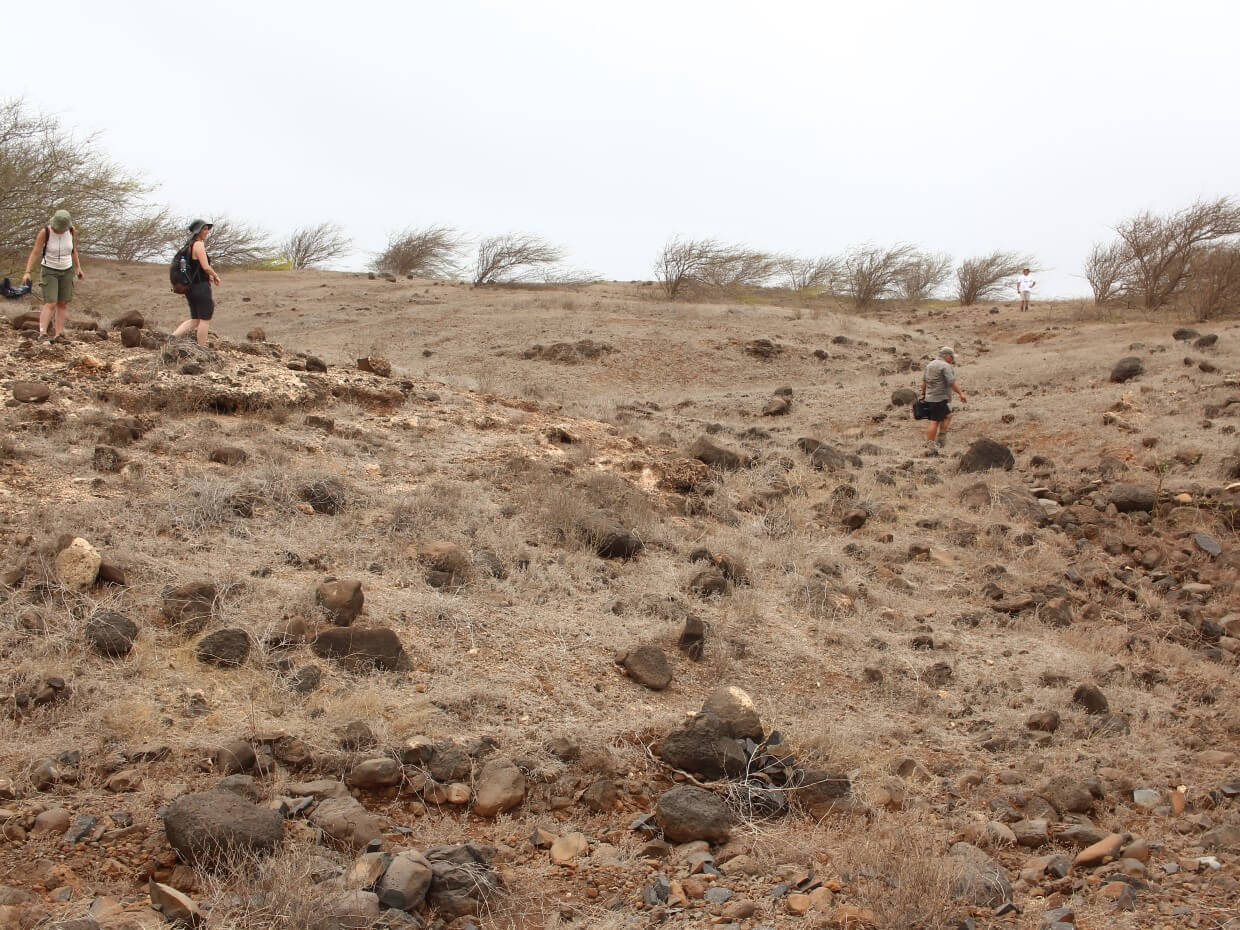Cabo Verde
Cabo Verde é o arquipélago mais meridional da Macaronésia, localizado a 600 km da costa ocidental de África, entre as latitudes 14°40′ e 17°30′ N e as longitudes 25°30′ e 21°30′ W. Cabo Verde é constituído por um conjunto de dez ilhas vulcânicas e alguns ilhéus, com as idades que variam entre 15,8 Ma no Sal e 3 Ma no Fogo (Ramalho, 2011).
A origem do arquipélago está associada ao ponto quente de Cabo Verde, com atividade vulcânica conhecida desde o Oligoceno (Ramalho, 2011) até ao presente, com a última erupção vulcânica de 2014/2015 na ilha do Fogo (Mata et al., 2017).
Das dez ilhas, são conhecidos depósitos fossilíferos marinhos em nove, com idades que variam entre o Miocénico e o Holocénico (Gudveig Baarli et al., 2013; Johnson et al., 2012, 2013, 2020; Mayoral et al., 2013, 2018; Johnson & Gudveig Baarli, 2015).
Explore a Paleobiodiversidade de Cabo Verde
Bibliografia
GUDVEIG BAARLI, B., A. SANTOS, E.J. MAYORAL, J. LEDESMA-VÁZQUEZ, M.E. JOHNSON, C.M. DA SILVA & M. CACHÃO, 2013. What Darwin did not see: Pleistocene fossil assemblages on a high energy coast at Ponta das Bicudas, Santiago, Cape Verde Islands. Geological Magazine, 150(1): 183–189.
JOHNSON, M.E. & B. GUDVEIG BAARLI, 2015. Charles Darwin in the Cape Verde and Galápagos archipelagos: The role of serendipity in development of theories on the ups and downs of oceanic islands. Earth Sciences History, 34 (2): 220–242.
JOHNSON, M.E., GUDVEIG BAARLI, B., M. CACHÃO, C.M. DA SILVA, J. LEDESMA-VÁZQUEZ, E.J. MAYORAL, R.S. RAMALHO & A. SANTOS, 2012. Rhodoliths, uniformitarianism, and Darwin: Pleistocene and Recent carbonate deposits in the Cape Verde and Canary archipelagos. Palaeogeography, Palaeoclimatology, Palaeoecology, 329–330: 83–100.
JOHNSON, M.E., B. GUDVEIG BAARLI, M. CACHÃO, C.M. da SILVA, R.S. RAMALHO, J. LEDESMA-VÁZQUES, E.J. MAYORAL & A. SANTOS, 2013. Coastal dunes with high content of rhodolith (coralline red algae) bioclasts: Pleistocene formations on Maio and São Nicolau in the Cape Verde archipelago. Aeolian Research, 8: 1–9.
JOHNSON, M.E., R.S. RAMALHO & C.M. DA SILVA, 2020. Storm-Related Rhodolith Deposits from the Upper Pleistocene and Recycled Coastal Holocene on Sal Island (Cabo Verde Archipelago). Geosciences, 10(11): 419.
MATA, J., S. MARTINS, N. MATTIELLI, J. MADEIRA, B. FARIA, R.S. RAMALHO, P. SILVA & M. MOREIRA, 2017. The 2014 e 15 eruption and the short-term geochemical evolution of the Fogo volcano (Cape Verde): evidence for small-scale mantle heterogeneity. Lithos, 288-289: 91–107.
MAYORAL, E.J., J. LEDESMA-VÁZQUEZ, B. GUDVEIG BAARLI, A. SANTOS, R.S. RAMALHO, M. CACHÃO, C.M. DA SILVA & M.E. JOHNSON, 2013. Ichnology in oceanic islands; case studies from the Cape Verde Archipelago. Palaeogeography, Palaeoclimatology, Palaeoecology, 2013(381-382): 47–66.
MAYORAL, E.J., A. SANTOS, J.A.G. VINTANED, J. LEDESMA-VÁZQUEZ, B. GUDVEIG BAARLI, M. CACHÃO, C.M. DA SILVA & M.E. JOHNSON, 2018. Upper Pleistocene trace fossils from Ponta das Bicudas, Santiago, Cape Verde Islands: Systematics, taphonomy and palaeoenvironmetal evolution. Palaeogeography, Palaeoclimatology, Palaeoecology, 498: 83–98.
RAMALHO, R.S., 2011. Building the Cape Verde Islands. Springer-Verlag Berlin Heidelberg, Berlin, p. 210.
Como citar:
MPDb (2023). Cabo Verde. Base de dados da Paleobiodiversidade da Macaronésia. https://macpaleo.uac.pt/pt/cabo-








